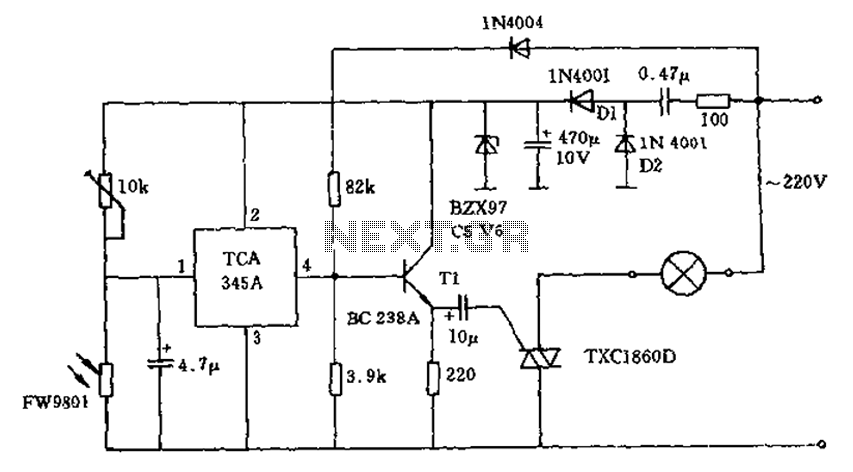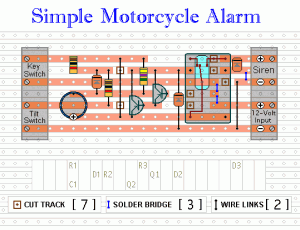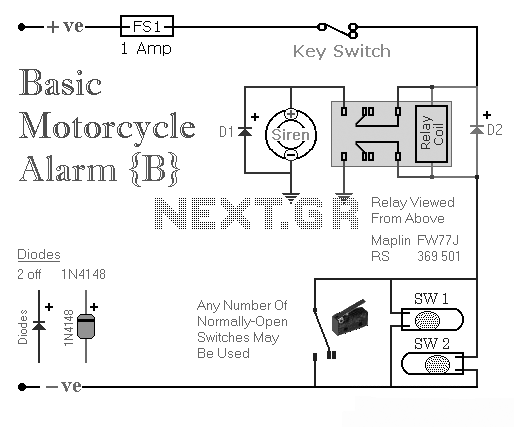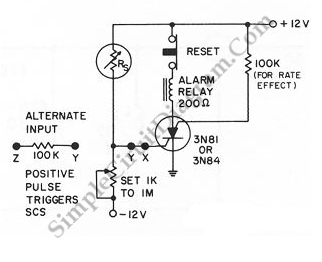
AUTO ALARM
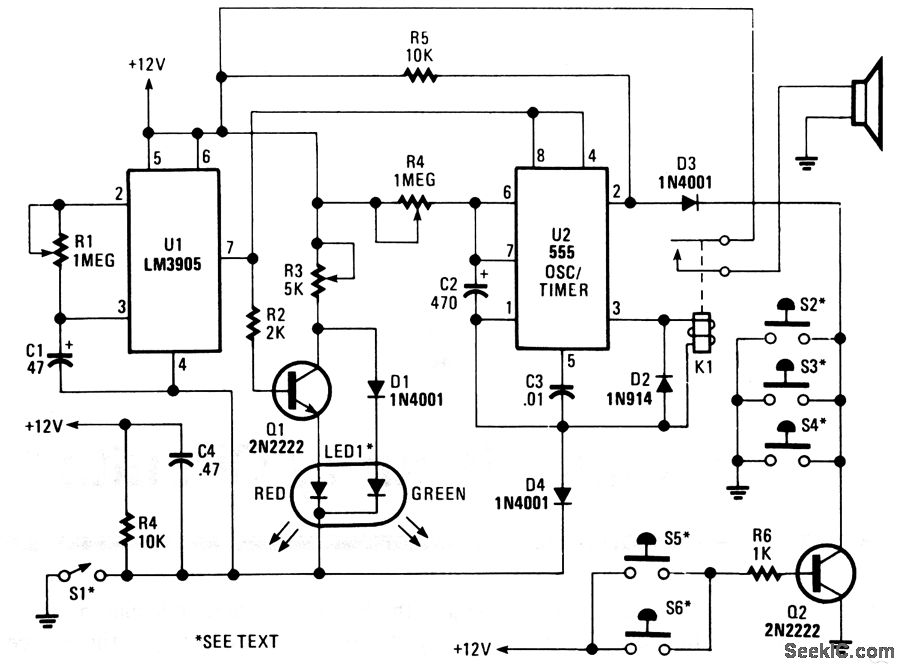
The alarm circuit is designed to provide a time delay of 0-47 seconds, which is determined by the combination of resistor R1 and capacitor C1. This delay allows the vehicle's motion sensor to stabilize after the switch is armed, facilitating the retrieval of items, such as groceries, from the trunk without the inconvenience of managing the key switch simultaneously. During this delay, half of LED1, which is a bi-colored, three-legged common cathode device, emits a green light. Simultaneously, pins 8 and 4 of U2, a 555 oscillator/timer, are held low by U1, a 3905 oscillator/timer, ensuring that the alarm remains silent. Once the delay period concludes, LED1 changes to red, signaling that the circuit is armed. At this moment, a ground signal at pin 2 of U2 drives pin 3 of U2 high, activating relay K1 and triggering the siren for a duration determined by the values of R4 and C2. After this time elapses, pin 3 is pulled low, K1 opens, and the circuit resets. The circuit can be manually reset by toggling the key switch. The illumination intensity of the LED is adjustable through potentiometer R3. Diode D1 ensures that the green segment of LED1 is completely turned off when transistor Q1 is activated, which switches the LED to red. It is crucial that resistors R4 and R5 are connected to the +V bus instead of pin 7 of U1 to prevent unintended triggering of U2 at the end of the initial delay.
The alarm circuit operates using a combination of analog timing and visual indicators to enhance user convenience and security. The time delay mechanism, governed by the R1/C1 combination, is critical for allowing the motion sensor to stabilize, which is essential in preventing false alarms. The bi-colored LED1 serves as a visual status indicator, transitioning from green to red to inform the user of the system's state. The use of a 555 timer integrated circuit (U2) provides reliable timing functions, while the 3905 timer (U1) ensures that the alarm remains inactive during the delay period.
The relay K1 is a pivotal component in the circuit, acting as a switch that activates the siren when the system is armed. The duration of the alarm sound is adjustable through the selection of R4 and C2, allowing for customization based on user preference or application needs. The manual reset capability enhances user control over the system, ensuring that the alarm can be easily rearmed after an event.
The design incorporates safety features, including the use of diode D1, which prevents back-feeding of current that could inadvertently activate the LED during the alarm state. The proper connection of resistors R4 and R5 to the +V bus is essential for maintaining circuit stability and preventing false triggers, which could compromise the reliability of the alarm system.
Overall, this alarm circuit exemplifies a well-engineered solution for vehicle security, combining user-friendly features with robust functionality to protect against unauthorized access while accommodating the user's day-to-day activities.In operation, the alarm circuit allows a 0-47 second time delay, as determined by the R1/C1 combination, after the switch is armed to allow the vehicle`s motion sensor to settle down. This allows you time to get a bag of groceries out of the trunk and not have the hassle of juggling the groceries and the key switch at once.
During the time delay, half of LED1, which is actually a single, bi-colored, three-legged common cathode device, lights green. At the same time, pins 8 and 4 of U2 (a 555 oscillator/timer) are held low by U1 (a 3905 oscillator/timer), causing the alarm to remain silent.
Once the delay is over, LED1 turns red, indicating that the circuit is armed. At that point, a ground at pin 2 of U2 forces pin 3 of U2 high, closing the contacts of K1 and sounding the siren for a time duration determined by R4 and C2. Once the time has elapsed, pin 3 is pulled low, K1 opens, and the circuit is again ready to go. The circuit can be manually reset by the simple expedient of opening and closing the key switch. Potentiometer R3 controls the LED`s illumination intensity. Diode Dl ensures that the green segment of LED1 is fully extinguished when Q1 is turned on-which turns the LED to red.
Resistors R4 and R5 must be connected to the +V bus, not to pin 7 of U1, otherwise U2 will mysteriously trigger itself each time the initial delay ends. 🔗 External reference
The alarm circuit operates using a combination of analog timing and visual indicators to enhance user convenience and security. The time delay mechanism, governed by the R1/C1 combination, is critical for allowing the motion sensor to stabilize, which is essential in preventing false alarms. The bi-colored LED1 serves as a visual status indicator, transitioning from green to red to inform the user of the system's state. The use of a 555 timer integrated circuit (U2) provides reliable timing functions, while the 3905 timer (U1) ensures that the alarm remains inactive during the delay period.
The relay K1 is a pivotal component in the circuit, acting as a switch that activates the siren when the system is armed. The duration of the alarm sound is adjustable through the selection of R4 and C2, allowing for customization based on user preference or application needs. The manual reset capability enhances user control over the system, ensuring that the alarm can be easily rearmed after an event.
The design incorporates safety features, including the use of diode D1, which prevents back-feeding of current that could inadvertently activate the LED during the alarm state. The proper connection of resistors R4 and R5 to the +V bus is essential for maintaining circuit stability and preventing false triggers, which could compromise the reliability of the alarm system.
Overall, this alarm circuit exemplifies a well-engineered solution for vehicle security, combining user-friendly features with robust functionality to protect against unauthorized access while accommodating the user's day-to-day activities.In operation, the alarm circuit allows a 0-47 second time delay, as determined by the R1/C1 combination, after the switch is armed to allow the vehicle`s motion sensor to settle down. This allows you time to get a bag of groceries out of the trunk and not have the hassle of juggling the groceries and the key switch at once.
During the time delay, half of LED1, which is actually a single, bi-colored, three-legged common cathode device, lights green. At the same time, pins 8 and 4 of U2 (a 555 oscillator/timer) are held low by U1 (a 3905 oscillator/timer), causing the alarm to remain silent.
Once the delay is over, LED1 turns red, indicating that the circuit is armed. At that point, a ground at pin 2 of U2 forces pin 3 of U2 high, closing the contacts of K1 and sounding the siren for a time duration determined by R4 and C2. Once the time has elapsed, pin 3 is pulled low, K1 opens, and the circuit is again ready to go. The circuit can be manually reset by the simple expedient of opening and closing the key switch. Potentiometer R3 controls the LED`s illumination intensity. Diode Dl ensures that the green segment of LED1 is fully extinguished when Q1 is turned on-which turns the LED to red.
Resistors R4 and R5 must be connected to the +V bus, not to pin 7 of U1, otherwise U2 will mysteriously trigger itself each time the initial delay ends. 🔗 External reference
